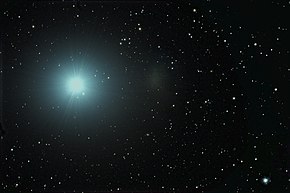| Leo I | |
|---|---|
 Leo I appears as a faint patch to the right of the bright star, Regulus. | |
| Observation data (J2000 epoch) | |
| Constellation | Leo |
| Right ascension | 10h 08m 27.4s[1] |
| Declination | +12° 18′ 27″[1] |
| Redshift | 285 ± 2 km/s[1] |
| Distance | 820 ± 70 kly (250 ± 20 kpc)[2][3] |
| Apparent magnitude (V) | 11.2[1] |
| Absolute magnitude (V) | −12.0[4] |
| Characteristics | |
| Type | E;dSph[1] |
| Mass | (2.0 ± 1.0) × 107 M☉ |
| Size | 2000 ly[5] |
| Apparent size (V) | 9.8′ × 7.4′[1] |
| Notable features | Milky Way satellite |
| Other designations | |
| UGC 5470,[1] PGC 29488,[1] DDO 74,[1] A1006,[1] Harrington-Wilson #1,[1] Regulus Dwarf[1] | |
Preview warning: Page using Template:Infobox galaxy with unknown parameter "image_size"
Leo I is a dwarf spheroidal galaxy in the constellation Leo. At about 820,000 light-years distant, it is a member of the Local Group of galaxies and is thought to be one of the most distant satellites of the Milky Way galaxy. It was discovered in 1950 by Albert George Wilson on photographic plates of the National Geographic Society – Palomar Observatory Sky Survey, which were taken with the 48-inch Schmidt camera at Palomar Observatory.[6][7]
- ^ a b c d e f g h i j k l "NASA/IPAC Extragalactic Database". Results for Leo I. Retrieved 2006-11-29.
- ^ I. D. Karachentsev; V. E. Karachentseva; W. K. Hutchmeier; D. I. Makarov (2004). "A Catalog of Neighboring Galaxies". Astronomical Journal. 127 (4): 2031–2068. Bibcode:2004AJ....127.2031K. doi:10.1086/382905.
- ^ Karachentsev, I. D.; Kashibadze, O. G. (2006). "Masses of the local group and of the M81 group estimated from distortions in the local velocity field". Astrophysics. 49 (1): 3–18. Bibcode:2006Ap.....49....3K. doi:10.1007/s10511-006-0002-6. S2CID 120973010.
- ^ Ruiz-Lara, T.; Gallart, C.; Monelli, M.; Fritz, T. K.; Battaglia, G.; Cassisi, S.; Aznar, M Luis; Russo Cabrera, A. V.; Rodríguez-Martín, I.; Salazar-González, J. J. (2021). "Dissecting the stellar content of Leo I: A dwarf irregular caught in transition". Monthly Notices of the Royal Astronomical Society. 501 (3): 3962–3980. arXiv:2012.07863. doi:10.1093/mnras/staa3871.
- ^ Cite error: The named reference
Pultarovawas invoked but never defined (see the help page). - ^ "Leo I". SEDS Messier Database. Retrieved 2006-05-15.
- ^ Van den Bergh, Sidney (2000). Galaxies of the Local Group (1st ed.). Cambridge University Press. pp. 243–245. ISBN 0-521-65181-6.